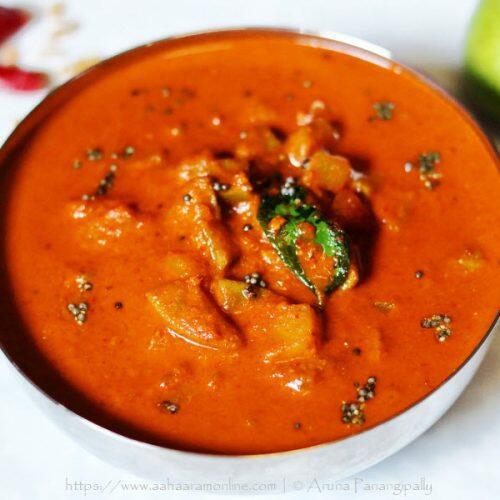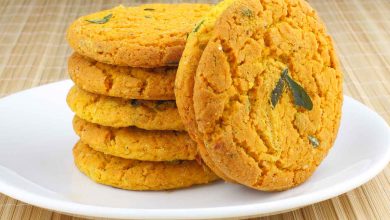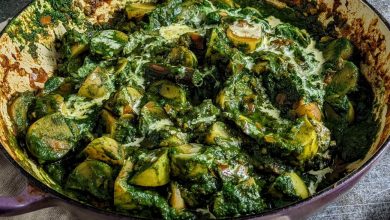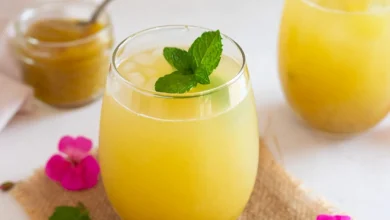Introduction
Love With Recipes, a trusted platform for authentic and detailed recipes, presents an immersive and comprehensive guide to preparing Mavinakayi Gojju, a quintessential South Indian mango curry that captures the essence of tangy, spicy, and aromatic flavors. This dish exemplifies the culinary finesse of South Indian cuisine, showcasing a perfect balance of sourness from raw mangoes, heat from dried red chillies, and depth from roasted spices and coconut. Whether it’s a festive occasion, a hearty lunch, or a weekend breakfast, Mavinakayi Gojju elevates any meal with its distinctive taste and rich aroma. The process involves careful selection of ingredients, precise roasting techniques, and a harmonious blending of spices, culminating in a flavor-packed curry that is both comforting and exciting.
Time
- Preparation Time: 15 minutes
- Cooking Time: 30 minutes
- Total Time: 45 minutes
Needed Equipment
- Pressure cooker
- Dry roasting pan or skillet
- Mixing bowls
- Grinder or blender (preferably a wet grinder or high-speed blender)
- Deep frying pan or kadai
- Cooking spoon and spatula
- Measuring spoons and cups
- Knife and chopping board
- Grater for coconut
- Storage jars or airtight containers
Tags
South Indian, Vegetarian, Mango, Curry, Vegan, Gluten-Free, Traditional, Spicy, Tangy
Serving Size
This recipe yields approximately 4–6 servings, depending on portion size and accompanying dishes.
Difficulty Level
Intermediate — requires attention to roasting spices, blending, and tempering techniques for optimal flavor.
Allergen Information
- Contains nuts or coconut (if using fresh grated coconut)
- Contains seeds (mustard, cumin, fenugreek)
- No gluten or dairy unless modified
Dietary Preference
Vegetarian, Vegan (if no ghee or dairy used)
Course
Main Course / Side Dish
Cuisine
South Indian
Ingredients
| Ingredient | Quantity |
|---|---|
| Raw Mango (Totapuri, skinned and chopped) | 2 Mangoes |
| White Urad Dal (Split) | 1 tablespoon |
| Chana Dal (Bengal Gram Dal) | 1 tablespoon |
| Cumin Seeds (Jeera) | 1/2 teaspoon |
| Methi Seeds (Fenugreek Seeds) | 1/2 tablespoon |
| Turmeric Powder (Haldi) | 1/4 teaspoon |
| Dry Red Chillies | 3 |
| Fresh Coconut (grated) | 1/4 cup |
| Jaggery | 1 tablespoon |
| Salt | To taste |
| Oil (preferably sesame or vegetable oil) | 1 tablespoon |
| Asafoetida (Hing) | 1/4 teaspoon |
| Mustard Seeds (Rai/Kadugu) | 1 teaspoon |
| Dry Red Chillies (for tempering) | 2 |
| Curry Leaves | Few sprigs |
Instructions
Step 1: Preparing and Cooking the Mangoes
Start by selecting firm, unripe, raw mangoes, preferably of the Totapuri variety, renowned for their tangy flavor and suitability for curries. Peel and chop the mangoes into medium-sized chunks, approximately 1 to 2 inches in size. This ensures they cook evenly and absorb the flavors of the spices well.
Place the chopped mangoes into a pressure cooker. Add a pinch of turmeric powder and enough water to cover the mango pieces, approximately 1/4 to 1/2 cup. The turmeric not only enhances the flavor but also aids in the cooking process, ensuring the mangoes soften uniformly while maintaining their shape. Seal the lid of the pressure cooker and cook over medium heat for about 2 to 3 whistles. This duration is crucial; overcooking may cause the mangoes to disintegrate, while undercooking may result in a less tender texture.
Once the pressure cooker has released pressure naturally, open the lid carefully. Transfer the cooked mangoes and the cooking liquid into a bowl. Using a fork or masher, gently mash some of the mango pieces to release their juices, creating a slightly thick pulp that forms the base of the curry. Set aside the mango pulp and pieces for the next steps.
Step 2: Roasting the Spices and Dal
In a dry skillet or roasting pan, gently toast the white urad dal and chana dal over medium heat. Stir continuously to prevent burning, and roast until they turn a golden brown, releasing a nutty aroma—this usually takes about 3 to 4 minutes. Proper roasting enhances their flavor and aids in digestion.
Next, add the dry red chillies, fenugreek seeds, and cumin seeds to the pan. Continue roasting for another 2-3 minutes until the spices become aromatic and slightly darkened. The fenugreek seeds should turn a darker shade, and the cumin seeds should crackle, indicating they are ready. Turn off the heat and let the roasted mixture cool slightly.
This step is crucial because roasting spices intensifies their flavor and prevents rawness, which can overpower the curry.
Step 3: Grinding the Masala
Transfer the cooled roasted dal and spices to a mixer grinder or wet grinder. Add the freshly grated coconut to the grinder. Blend into a smooth, thick paste, adding a few teaspoons of water if necessary to facilitate blending. The coconut adds richness and aroma, balancing the tanginess of the mangoes and the spices.
Ensure the paste is well combined, with no large spice particles remaining. The consistency should be thick and aromatic, ready to be incorporated into the curry.
Step 4: Preparing the Mango and Coconut Mixture
Take about three-quarters of the cooked mango pieces and add them to the grinder along with the jaggery, salt, and the freshly prepared coconut-spice paste. Pulse a few times to incorporate all flavors, resulting in a coarse but well-blended mixture. The jaggery provides subtle sweetness that balances the curry’s tanginess, while the salt enhances overall flavor.
Adjust the blending to your preference—some may prefer a chunkier texture, others a smoother paste. It’s essential to taste the mixture and adjust the salt or jaggery if needed.
Step 5: Tempering the Curry
In a deep pan or kadai, heat the oil over medium heat. Once hot, add the mustard seeds and allow them to crackle. This process releases their nutty aroma and is vital for authentic flavor. When the mustard seeds start popping, add the dry red chillies and curry leaves. Sauté for about 30 seconds until fragrant.
Add the asafoetida (hing) and stir quickly to distribute evenly. This spice adds a subtle pungency and enhances the overall aroma of the curry.
Step 6: Cooking the Final Curry
Carefully add the ground mango and coconut mixture to the pan, stirring continuously to prevent sticking. Pour in the remaining 1/4 cup of water from the blender to rinse out any residual paste and add it to the pan. Stir well, ensuring the mixture is combined uniformly.
Bring the curry to a gentle boil over medium heat, then reduce the heat to low and simmer for 10-15 minutes. Stir occasionally to prevent burning or sticking at the bottom. The curry should thicken slightly and develop a rich, aromatic flavor. Adjust the consistency by adding more water if needed, but keep in mind that a thicker curry is traditional.
Step 7: Cooling and Storage
Once the curry has reached the desired thickness and aroma, turn off the heat. Let it cool to room temperature before transferring to airtight containers or jars. The curry can be stored in the refrigerator for 2-3 days, with flavors deepening over time. Always use clean utensils when serving to maintain freshness and prevent spoilage.
Preparation Tips
- Choosing Mangoes: Select firm, slightly unripe mangoes with a firm texture and tangy flavor, such as Totapuri. Overripe mangoes will make the curry overly sweet and less tangy.
- Roasting Spices: Proper roasting is key—do not rush this step. It unlocks essential oils and intensifies flavor. Use a low to medium flame and stir continuously.
- Grinding Technique: For an authentic texture, use a wet grinder if possible. This produces a smoother paste and enhances flavor.
- Adjusting Spice and Sweetness: Modify the number of red chillies or jaggery according to your taste preference. For milder curry, reduce chillies; for spicier, add more.
- Consistency: The curry can be served thick or slightly watery. Adjust water content at the final simmer stage.
Nutritional Information
| Nutrient | Amount per Serving (approx.) |
|---|---|
| Calories | 150 kcal |
| Protein | 2 g |
| Carbohydrates | 35 g |
| Fiber | 4 g |
| Fat | 5 g |
| Sodium | 250 mg |
Tips and Tricks
- Use Fresh Coconut: Freshly grated coconut greatly enhances the aroma and taste. Frozen or dried coconut can be used but may alter flavor.
- Roasting Dal and Spices: Don’t skip roasting—this step is essential for depth of flavor.
- Balance Flavors: Taste and adjust salt, jaggery, and spice levels before final simmering.
- Make Ahead: The curry tastes even better the next day as flavors meld. Prepare in advance for convenience.
- Serving Temperature: Serve at room temperature or slightly warm for maximum flavor impact.
Add-ons
- Fresh coriander leaves for garnish
- Additional chopped onions or tomatoes for variation
- Grated fresh ginger or garlic for extra aroma
- Ghee drizzled on top before serving
Side Dishes
- Steamed rice (preferably plain or ghee rice)
- South Indian dosa or idli
- Roti or chapati
- Vegetable stir-fry or poriyal
Improvements
- Incorporate a hint of tamarind pulp for added tanginess.
- Add roasted peanuts or cashews for crunch and richness.
- Use a variety of mangoes for layered flavor profiles.
- Experiment with different oils such as coconut oil for authentic aroma.
Save and Store
Keep the curry refrigerated in airtight containers for up to 2-3 days. For longer storage, freeze in portions—thaw and reheat gently before serving. To reheat, simmer on low heat to preserve flavor and texture. Always check for spoilage before consumption.
FAQ
Can I make Mavinakayi Gojju vegan?
Yes, this recipe is naturally vegan when using vegetable oil and no dairy products. Avoid ghee if strict veganism is desired.
Can I use other types of mangoes?
While Totapuri is preferred for its tanginess, unripe Alphonso or Kesar mangoes can be used, but they will alter the flavor profile slightly.
Is it necessary to pressure cook the mangoes?
Pressure cooking speeds up the process and ensures soft, well-cooked mangoes. Alternatively, simmer mango chunks in a covered pot until tender, which takes about 15-20 minutes.
How do I adjust spice levels?
Reduce or increase the number of dry red chillies during roasting or add fresh green chilies during tempering for a milder or spicier curry.
Can I add protein to this curry?
This dish is traditionally vegetarian and vegan. To add protein, serve with boiled eggs or a side of lentils or legumes.
Conclusion
Mavinakayi Gojju stands as a testament to the vibrant, aromatic, and bold flavors characteristic of South Indian cuisine. Its simple ingredients conceal a depth of flavor that evolves over time, making it a versatile dish suitable for both everyday meals and special occasions. By mastering the roasting, blending, and tempering techniques detailed above, you can create a curry that is authentically delicious, aromatic, and satisfying. As you explore variations and enhancements, this dish can become a staple in your culinary repertoire, embodying the rich tradition of South Indian home cooking. Remember, the key to perfection lies in quality ingredients, patience in roasting, and balance in flavors. Happy cooking!
References
- South Indian Cooking Techniques — “The Ultimate Guide,” by Ritu Dalmia, 2015.
- Traditional South Indian Recipes — “Indian Food Lab,” authentic recipes sourced from seasoned chefs.





